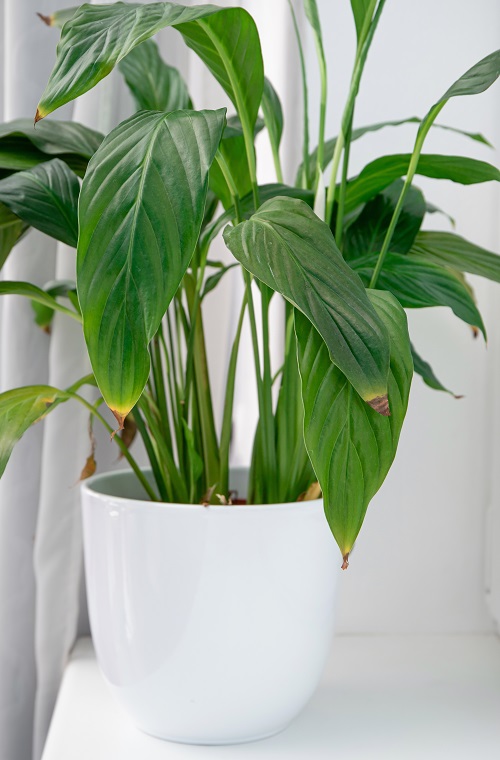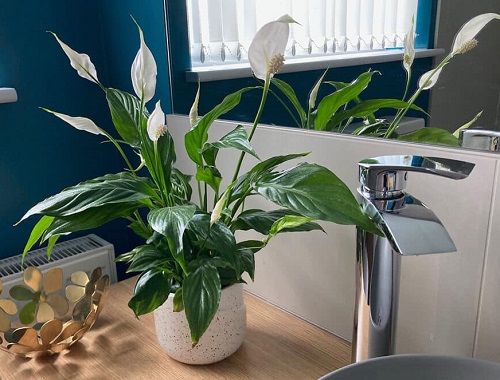Worried about your Peace Lily Brown Tips? Learn the reasons behind them and find effective solutions to bring back its vigour.
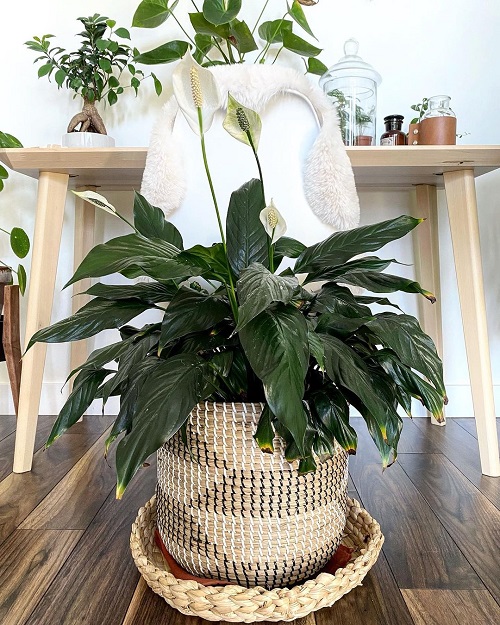
Peace lilies are renowned for their elegant green leaves and graceful white blooms, making them a popular choice among indoor plant enthusiasts. However, Peace Lily Brown Tips can be a common issue and that’s why we are here to help you out!
Find Why is My Peace Lily Drooping, Turning Yellow, Not Flowering and Dying? here
Reasons Behind Peace Lily Brown Tips
1. Inadequate Watering
Reason: One of the primary causes of Peace Lily Brown Tips is inconsistent watering. Peace lilies prefer evenly moist soil, but they are sensitive to both overwatering and underwatering.
Signs: The leaf tips turn brown and may start to droop if the plant is underwatered. On the other hand, overwatering can lead to root rot, which also manifests as brown tips.
Solution: Ensure that you water your peace lily when the top inch of soil feels dry to the touch. Do not let the soil go dry for an extended period of time.
Read about How to Fix and Save Overwatered Peace Lily here
2. Low Humidity
Reason: Peace lilies originate from tropical rainforests, so they thrive in high-humidity environments. Dry indoor air can lead to moisture loss from the leaves, causing brown tips.
Signs: Brown tips that develop on the edges of the leaves, often accompanied by a general browning of leaf surfaces, indicate low humidity stress.
Solution: Increase humidity around your peace lily by misting the leaves regularly, placing a tray of water near the plant, or using a room humidifier. This will help maintain the desired moisture level for the plant’s health.
3. Excess Fertilization
Reason: Overfeeding your peace lily with too much fertilizer or using it too frequently can lead to the accumulation of salts in the soil. This buildup can interfere with the plant’s ability to take up water and nutrients, resulting in Peace Lily Brown Tips.
Signs: Brown tips accompanied by yellowing or browning of the leaf’s margins indicate excess fertilizer.
Solution: Apply a balanced liquid fertilizer, after diluting it to 1/4 of its strength, every 4-6 weeks during the growing season. Avoid feeding the plant in winters.
4. Sun Scorch

Reason: Sun scorch happens when your peace lily gets too much direct sunlight. This means the sun’s rays are too strong for the plant to handle.
Signs: You’ll notice the tips of the leaves turning brown and dry. It might look like they’re burnt. This browning could gradually move further down the leaf if the sun exposure continues.
Solution: Move your peace lily to a place with less direct sunlight. Find a spot where it gets bright, indirect light instead. This will help prevent the leaves from getting damaged and turning brown.
Read Common Peace Lily Problems and How to Fix Them here
5. Age
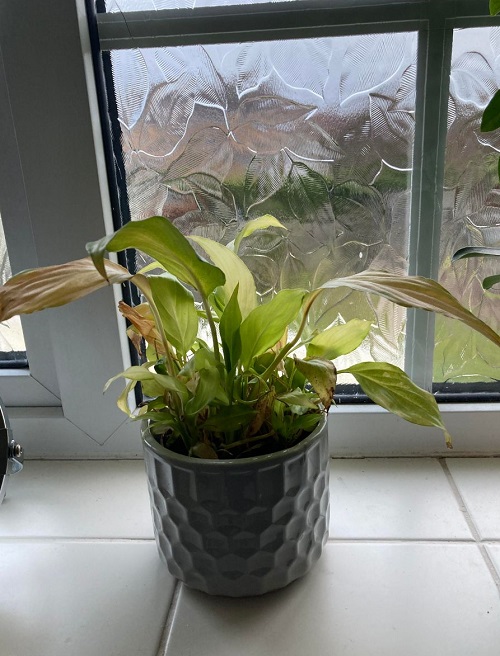
Reason: As your peace lily gets older, its leaves naturally age and wear out. This can lead to the development of Peace Lily Brown Tips.
Signs: You’ll notice that the older leaves, usually at the bottom of the plant, start turning brown at the tips. The rest of the leaf might still be healthy and green.
Solution: Trim off the brown parts using clean scissors or pruning shears. Regularly removing older leaves can keep your peace lily looking fresh and vibrant. Also, ensure that your plant gets proper care with appropriate watering and light conditions to reduce stress on the older leaves.
6. Lack of Drainage
Reason: When your peace lily’s pot doesn’t have proper drainage or the soil doesn’t let water flow away, the roots can become waterlogged. This excess water can cause Peace Lily Brown Tips.
Signs: You’ll see brown tips on the leaves, which might also start to droop or wilt. The browning is often more pronounced on the lower leaves.
Solution: Make sure the pot has drainage holes at the bottom. Use a well-draining potting mix that allows excess water to escape. When watering, ensure that the water doesn’t accumulate in the saucer under the pot.
7. Sudden Temperature Changes
Reason: Peace lilies are sensitive to sudden changes in temperature. If the environment around your peace lily experiences drastic temperature swings, it can lead to Peace Lily Brown Tips on the leaves.
Signs: Look for brown or blackened tips on the leaves, which might also become limp or wilted. The damage is often more noticeable on the leaves that are directly exposed to temperature changes.
Solution: Avoid placing it near drafty windows, air conditioning vents, or heaters. If you need to move your plant, do it gradually over a few days to allow it to acclimate to the new temperature. Providing consistent and moderate temperatures will help prevent the stress that leads to brown tips on the leaves.
Read Amazing Peace Lily Benefits Proven In Studies here
8. Use of Improper Soil
Reason: If your peace lily is planted in the wrong type of soil, it can lead to brown tips on the leaves. Peace lilies prefer light and well-draining soil; using the wrong one can create problems.
Signs: Look for brown tips on the leaves, which might also have a yellowish tint. The plant might not grow as well as it should.
Solutions: Re-pot your peace lily in potting mix made of – Peat Moss or Coco Coir: 2 parts (Provides moisture retention and improves soil structure), Perlite: 1 part (Enhances aeration and drainage, preventing waterlogged soil), and Pine Bark or Composted Bark: 1 part (Adds organic matter and improves water and nutrient retention).
9. Use of Tap Water
Reason: Peace lilies are sensitive to the minerals and chemicals present in tap water. If you water your peace lily with tap water that has high levels of chlorine, fluoride, or other impurities, it can lead to Peace Lily Brown Tips.
Signs: Look for brown or blackened tips on the leaves, which might also have a yellowish hue. The edges of the leaves may appear burned or dried out.
Solution: Use filtered or distilled water for watering your peace lily. If using tap water, let it sit out overnight before watering to allow the chlorine to dissipate.
10. Too Much Sunlight
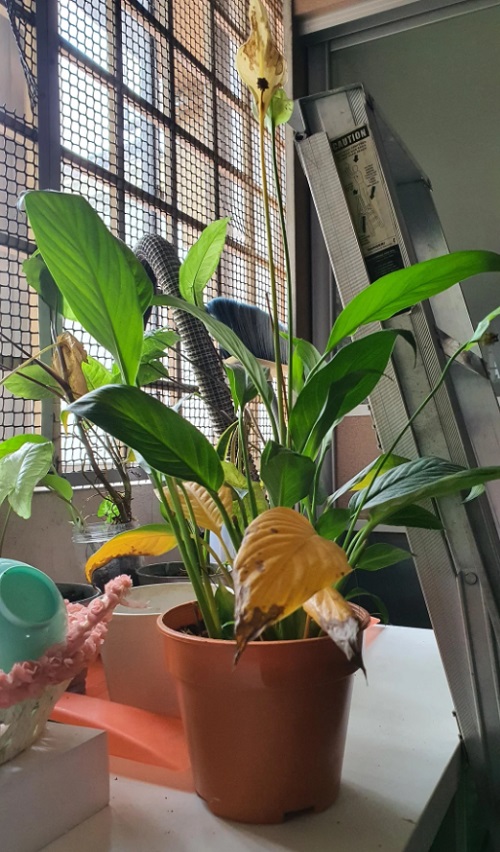
Reason: Peace lilies thrive in indirect or filtered light. When exposed to excessive sunlight, the intense rays can lead to brown leaf tips. The plant’s leaves are sensitive and can get overwhelmed by too much sunlight.
Signs: Look for brown or yellowish tips on the leaves, especially on those facing the sun. The brown areas may be dry or crispy to the touch.
Solution: To prevent brown leaf tips due to excessive sunlight, relocate your peace lily to a spot where it receives bright but indirect light. You can also place it a few feet away from windows or use sheer curtains to filter the sunlight.





